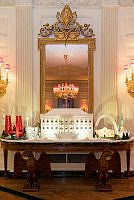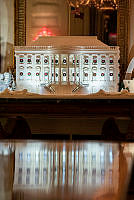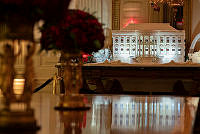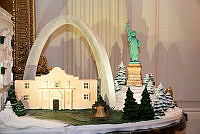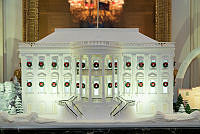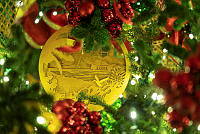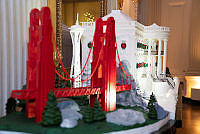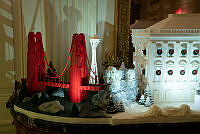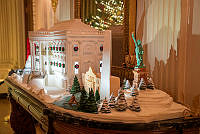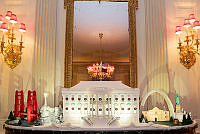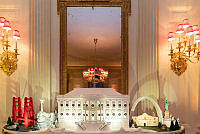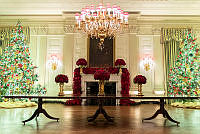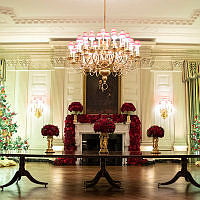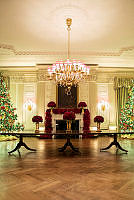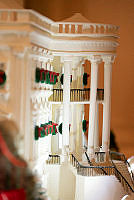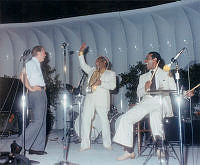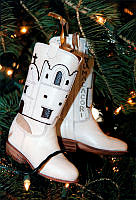Rubenstein Center Scholarship
Vietnam War Protests at the White House
On November 1, 1963, a group of military officials overthrew the South Vietnamese government and assassinated President Ngo Dinh Diem after he refused to resign—all with the tacit approval of the John F. Kennedy administration.1
While U.S. involvement in Vietnam dated back to the Dwight Eisenhower administration, the escalation of the war during the 1960s and 1970s dominated national politics, tarnished the United States’ reputation abroad, and cost 58,000 Americans and over 3 million Vietnamese their lives.
President John F. Kennedy was assassinated just three weeks after the fall of the South Vietnamese government, so his intentions for the future of Vietnam remain a mystery. Historians and former government officials that served in both the Kennedy and Johnson administrations debate whether the president would have increased military involvement or withdrawn military personnel.2 His successor, President Lyndon B. Johnson, felt compelled to defend the new South Vietnamese government against Vietnamese Communists. More importantly, Johnson and many of his advisors feared a widespread communist plot in the larger context of the United States’ Cold War with the Soviet Union.
In 1965, President Johnson ordered Operation Rolling Thunder, a systematic bombing campaign of North Vietnam and authorized American troops to begin an offensive campaign. By 1968, over 500,000 forces were serving in Vietnam.3 In May of that year, Johnson announced that the U.S. government would participate in formal peace talks in Paris. The negotiations remained deadlocked, partly because then-presidential candidate Richard Nixon encouraged the South Vietnamese representatives to refuse a deal until he assumed office.4 In January 1973, all sides agreed to a peace agreement and Nixon ordered an end to all offensive military action. Two years later, North Vietnam captured Saigon, the capital city of South Vietnam, and the war officially ended.5

Vietnam War Protestors outside White House gates, including Coretta Scott King and Dr. Benjamin Spock.
Lyndon B. Johnson Presidential Library and Museum/ NARAFrom the very beginning of the war, there were U.S. citizens who opposed American military involvement in the conflict. Protestors focused on Vietnam’s lack of strategic value to American security and argued that manpower and resources should not be spent on a nation that did not threaten United States’ national security or interests. Early protests were organized by peace activists that unilaterally opposed American intervention abroad during the Cold War and students who were at risk for the draft. Like many generations before them, they followed the example of the Women’s Suffrage Movement and mobilized in front of the White House.
The size of the protests varied depending on the day, but the numbers sometimes swelled to the thousands. On June 8, 1967, 400 buses brought over 30,000 protestors from New York City to the White House.6 The Johnson family acknowledged that they could hear the protests from inside the White House. The chant, “Hey, hey LBJ, how many kids did you kill today?” was particularly hard to ignore.
The protests found their way into the White House as well. On March 11, 1965, a protestor on a public tour threw bladders of pig’s blood on the carpet in the State Dining Room. White House employees also complained of repeated acts of car vandalism, break-ins, and indecent exposure.7
Invited guests at the White House also used the opportunity to argue against the war. On June 14, 1965, Johnson hosted the White House Festival of the Arts—a mass fair on the South Grounds of the White House. Performances by artists like Gene Kelly, Duke Ellington, Roberta Peters, Marian Anderson, Mark Van Doren, John Hersey, Saul Bellow, George Kennan, and Robert Lowell were planned over the course of the day. Two weeks prior to the event, Lowell canceled his appearance in a widely-publicized letter to President Johnson, blaming American involvement in Vietnam. At the event, many artists also used the platform to share their opposition to the war.8

Eartha Kitt asked President Johnson a question at a luncheon on January 18, 1968.
Lyndon B. Johnson Presidential Library and Museum/NARALowell was not the only entertainer to broach politics with the first family. On January 18, 1968, the Johnsons invited actress and singer Eartha Kitt to the White House for a luncheon to celebrate her charity work for at-risk youth. At the event, Kitt defended anti-Vietnam protestors. In her remarks, she criticized the Johnsons and the war: “They feel they are going to raise sons — and I know what it’s like, and you have children of your own, Mrs. Johnson — we raise children and send them to war.” According to a New York Times report on the event, Kitt’s comments brought First Lady “Lady Bird” Johnson to tears. After the luncheon, the Secret Service requested an intelligence report on Kitt’s background and connections. While President Johnson’s involvement is unclear, these efforts likely helped to blacklist Kitt from Hollywood for the next several decades.9

A group of protestors march in front of the White House on January 19, 1968 in support of singer Eartha Kitt and her vocal denunciation of the Vietnam War.
Library of CongressProtests also spread across the country, with schools and universities serving as hot-spots of agitation. After President Johnson abolished the draft-deferment option for graduate students, professors taught students legal ways to resist the draft, and students organized hunger strikes and class boycotts. Other protestors focused on draft offices—they raided offices, seized draft cards, and lit them on fire.10
These protests represented a shift in the focus in the anti-war movement and the individuals involved. Whereas the early protests had focused more on the White House, later protests targeted Congress and the military. Veterans that had returned from Vietnam added their voices to the crowd and shared harrowing stories of atrocities and violence. If the president would not listen to their pleas, they hoped they could convince Congress to defund the war or influence military policy. On October 21, 1967, 100,000 people gathered at the Lincoln Memorial. After the demonstration, about half of the crowd marched to the Pentagon, broke through military policy lines, and fought their way inside the Pentagon.11

This photo shows veterans, including soldiers who had served in Vietnam, protesting the conflict outside the Lincoln Memorial on October 21, 1967.
Frank Wolfe, White House Photograph Office, Lyndon B. Johnson AdministrationThe protests continued after President Richard Nixon took office and announced an escalation of the war into neighboring Cambodia in 1970. After Nixon’s inauguration, the Secret Service appealed to Congress, with the president’s encouragement, for legislation that would limit protests in Lafayette Square. Protestors were supposed to register in advance of their arrival and the National Park Service was charged with maintaining order. The Secret Service requested the right to enforce the rules and bring felony charges against protestors that defied the rules.12
While Nixon disagreed with the protestors and worked behind the scenes to limit their access to the White House, their anger often kept him up at night. During the early morning hours of May 9, 1970, Nixon looked out the windows in the southwest corner of the White House and saw protestors gathered around the Washington Monument. He called for his valet and drove to the Lincoln Memorial at 4:35 am with his Secret Service detail in tow. He spent the next hour speaking with protestors and listening to their views. Nixon reportedly said that he knew most of them would not understand his position on the war, but that he “hoped that they would not allow their disagreement on this issue to lead them to fail to give us a hearing on some other issues where we might agree. And also particularly I hoped that their hatred of the war, which I could well understand, would not turn into a bitter hatred of our whole system, our country and everything it stood for.”13
The biggest statement against the war during Nixon’s administration occurred in early May 1971, when a massive protest descended upon Washington, D.C. with the slogan, “If the government won’t stop the war, we’ll stop the government.” Activists camped out for a few days across the region before marching into the city on May 3. Over 25,000 protestors flooded the streets and built temporary barricades to halt traffic. The Nixon administration responded with a police force of 12,000 men and arrested 7,000 protestors. While the effort did not stop traffic for long, the enormity of the protest pushed Nixon to accelerate the nation’s exit from Vietnam.14 Protests continued until American involvement in the war ended in January 1973.

This photograph by National Geographic Service photographer James P. Blair shows a group of women protesting the Vietnam War outside the North Gates of the White House in June 1966.
White House Historical Association



